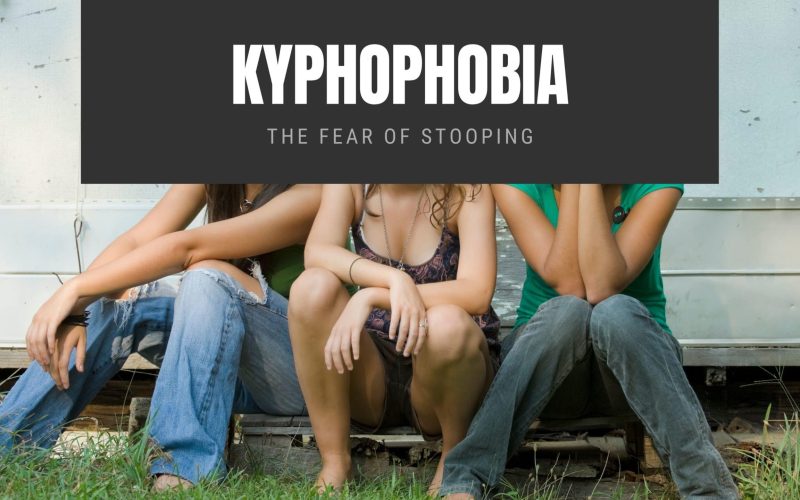The fear of stooping may just be more real than you ever imagined. Gestures are a normal part of communication; some people find it easier to express themselves with such bodily movements.
Kyphophobia is defined as the irrational fear of stooping. A person who has this phobia can expect to feel a very high amount of panic or anxiety from the mere thought of stooping, let alone actually making such bodily movements.
In fact, the anxiety they feel may be so intense that they may also have to endure a full-blown panic attack because of it.
Although an influx of anxiety as great as that will not always be the situation for everyone who suffers from kyphophobia, there is still a high possibility of it occurring nonetheless.
Someone who experiences a full-blown panic attack because of their kyphophobia should expect to notice symptoms such as an increased heart rate, higher blood pressure, trembling, an increased rate of breathing, muscle tension, and excessive sweating, among many other symptoms.
Although, in the same way, some people may not have anxiety attacks, others may also not suffer panic attacks as a symptom of kyphophobia.
Someone who suffers from kyphophobia may find themselves consciously doing things to avoid the object of their fear.
These people may take this avoidance behavior to the extreme by ensuring that there is no possibility of exposure to stooping in any form or way.
For example, someone who has this phobia may deliberately refuse to bend down to pick up something, regardless of whether or not the object that needs to be picked is essential or desired.
This kind of excessive worry and irrational thinking is very likely to be a primary cause of their mental anguish.
Although some people with this condition may actively do things to avoid their fear in an attempt to significantly reduce their chances of suffering any immediate anxiety, such behavior may also worsen the symptoms of hydrophobia that they suffer in the long term.
This is because they will unknowingly justify their fear of stooping by actively avoiding it.
Symptoms of Kyphophobia
As is the situation with almost every other phobia known to man, someone who has kyphophobia can expect to suffer anxiety as one of the most prominent symptoms of the fears they deal with.
Also, as mentioned previously, the anxiety they feel may be so extreme that they may also have to deal with full-blown panic attacks because of it.
Depending on how severe their panic attack is, they may sometimes have to be hospitalized. However, this may vary from one person to another and will greatly depend on many factors.
Furthermore, someone who has kyphophobia may go to some painstaking efforts to see to it that they do not have to come into contact with their wildest fear in any way.
This may mean that the person with kyphophobia avoids areas where they may have to come in contact with their fear and actively does things to prevent it from happening by trying a more hands-on approach.
Below are some of the more common symptoms of fear of stooping or kyphophobia:
- Anxiety when they think of stooping
- Constantly avoiding situations that require them to stoop
- Inability to cope with their stress or anxiety
- Muscle tension, sweating, and shakiness
- May deal with panic attacks
Causes of Kyphophobia
Like every other phobia you will learn about, there are no definitive causes of the fear of stooping or kyphophobia.
Nevertheless, environmental and genetic factors may play vital roles in developing such fears and conditions.
For instance, if a person with a fear of stooping has a family history of mental illness, mostly of specific phobias or anxiety disorders, then they may have a greater chance of developing the fear of stooping or kyphophobia.
This may also be due to them generally having a genetic predisposition to suffering from mental illnesses in general.
If someone were found to have such genetics, then all it may take is a single occurrence of some traumatic event for them to suffer a full-blown kyphophobia.
Eventually, any emotionally painful event that has to do with the various symptoms or fears that are associated with kyphophobia in one way or another may be all it takes for someone to get this condition as long as they have the right genetics.
Although there is no record of the exact causes of kyphophobia, the consensus among many doctors or mental health professionals is that both environmental and genetic factors play essential roles in the development of any mental disorder.
So, a closer look at the two different parameters may shed some light on whether or not you are at risk for developing kyphophobia.
Kyphophobia (Fear of Stooping) Treatments
Just as no phobia exists with a known cause, there are also no specific treatments for any phobia, and that includes Kyphophobia.
Nevertheless, there is hope for recovery as there are still many forms of safe treatment alternatives that can help to improve many symptoms of kyphophobia significantly.
Some of these treatments include cognitive-behavioral therapy (CBT), exposure therapy, and psychiatric medications.
Exposure Therapy for Fear of Stooping Phobia
Exposure therapy is one of the most popular forms of treatment for those who suffer from phobias.
The way exposure therapy works is by having the therapist slowly expose the person with the phobia to the object of fear over a specific period.
Regarding the fear of stooping, the therapist may have to begin by exposing the patient to pictures of someone stooping and eventually have the patient try stooping down insofar as they are willing and ready to do so.
This would be in an attempt to desensitize the person with this phobia to their fear by repetitively exposing them to stooping.
Theoretically, the more a person is exposed to something they fear, the less they will feel bothered by such fears over time.
Cognitive-behavioral Therapy for Fear of Stooping
CBT is one other very common type of treatment that is usually used to help those who suffer from generalized anxiety disorder and obsessive-compulsive disorder, among many other conditions.
Nevertheless, it may also be an effective form of treatment for people who suffer from phobias such as kyphophobia.
Cognitive-behavioral therapy works by having the therapist help the person with a phobia to uncover why it is that they are afraid or feel the way they do about the object of their fear.
Someone who has kyphophobia and decides to partake in CBT can expect to figure out why it is that they think or feel the way they do about stooping, among other things.
Understanding things like this may help someone dealing with kyphophobia to take an approach that is more pragmatic when they are thinking about their irrational fear of stooping.
If you or someone you know may have kyphophobia, or you notice any of its symptoms that have been described above, then it is time for you or that person to seek help.
We hope that you have found this article helpful so far. If so, kindly share your thoughts with us by commenting below.








